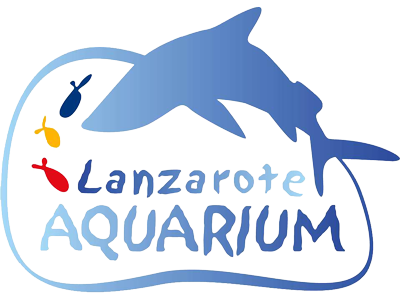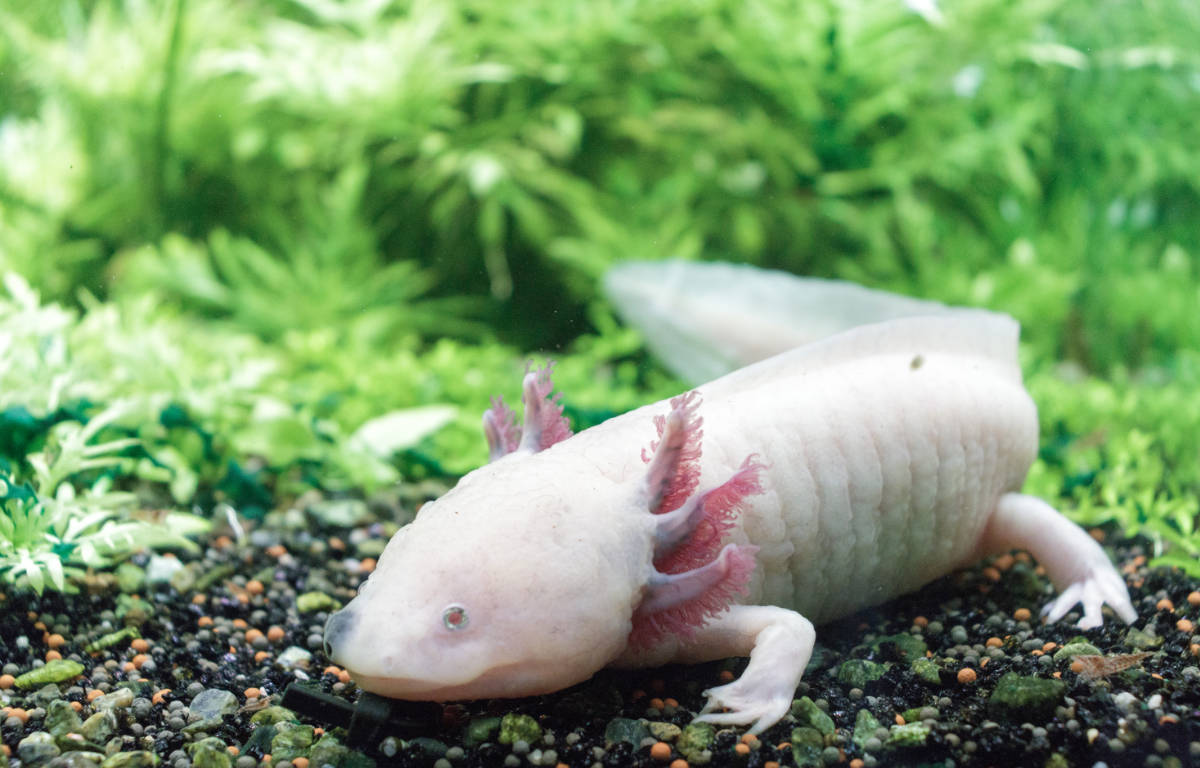Introduction to the Axolotl
The axolotl (Ambystoma mexicanum) is a neotenic salamander endemic to the lake system of the Valley of Mexico, especially the canals of Xochimilco. Native to Mexico, its natural distribution is restricted to this specific region.
Unlike most amphibians, axolotls retain larval traits throughout life: an elongated, tadpole-like body, external gills, and underdeveloped limbs. They reach sexual maturity without completing metamorphosis, a rarity that sets them apart in the amphibian world.
Adults typically measure 15–35 cm and display varied coloration, including leucistic forms. Their flexible bodies can regenerate lost parts—an extraordinary adaptation and a key to their scientific importance.
The name “axolotl” comes from Nahuatl and means “water monster,” reflecting the species’ deep cultural significance in Mexico. Axolotls depend on clean, fresh water; degradation of these habitats has driven the species toward extinction.
Characteristics & Habitat
Axolotls inhabit shallow, cool, plant-rich waters—such as Xochimilco’s canals—with an ideal temperature range of 6–20 °C. Mexico is both their origin and the center of their ecological and cultural relevance.
They are nocturnal, oviparous predators, protective of their clutches, and non-venomous. In the wild they may live alone or in small groups. Their habitat is critically threatened by pollution and invasive species, making Xochimilco one of the last natural refuges.
Water contamination and the introduction of predatory fish are the main threats in Xochimilco. Documented cases show severe declines where these pressures are highest.
Scientific Classification
The axolotl belongs to family Ambystomatidae within the order Caudata (tailed amphibians). Its lifelong larval state (neoteny) and exceptional ability to regenerate organs and limbs make it a standout organism for biology and regenerative medicine. Understanding its taxonomy helps place it in the animal kingdom and appreciate both the traits it shares with related salamanders and the features that make it unique.
Conservation Status
The axolotl is listed as Critically Endangered by the IUCN due to pollution, overexploitation, and invasive species. Sharp population declines have been documented in Xochimilco and Chalco, where desiccation and contamination are severe. Recent conservation studies emphasize urgent habitat restoration and threat control to prevent extinction and highlight the role of environmental education.
Conservation Measures
The primary goal is to ensure species survival while preserving its role as a scientific model in regeneration and genetics.
Efforts focus on restoring Xochimilco’s wetlands and expanding environmental education. Ex-situ colonies around the world support research and safeguard genetic diversity. Reintroduction is not recommended until threats are mitigated and risks are properly assessed; mixed outcomes from past releases underscore the need for rigorous evaluation.
The Xochimilco Ecological Park protects remnant populations and leads rescue plans. Global collaboration—institutions, researchers, and the public—is essential to secure the axolotl’s future.
Axolotl as a Model Organism
Thanks to its ease of breeding and handling in captivity, the axolotl is used to study development, metamorphosis, cardiac defects, and neural tube closure—with the broader aim of advancing regenerative medicine.
Thyroid hormone can induce metamorphosis into a terrestrial salamander in laboratory settings. Genetics research explores mutations and color morphs, illuminating inheritance and phenotypic diversity. Recent studies reaffirm the axolotl’s value for understanding tissue and organ regeneration.
Care & Feeding (Captivity)
Axolotls require an aquarium that mirrors their natural conditions:
Cold, filtered, well-aerated freshwater; a chiller is often needed.
Correct filter media is crucial for a healthy nitrogen cycle and stable water quality.
Low lighting to mimic their dim, vegetated habitat.
Diet should be varied and life-stage appropriate (e.g., worms, small crustaceans, formulated amphibian feeds). Feed the right amount to avoid overfeeding and water pollution. Replace filter media and perform maintenance several times per month as the system requires. With proper husbandry, axolotls are robust, but consistent care is key to long-term health.
Metamorphosis & Growth
Occasionally, axolotls complete metamorphosis into terrestrial salamanders, especially under induced conditions; however, this is stressful and generally undesirable for welfare. Despite sexual maturity, adults retain larval traits due to neoteny.
Growth depends on nutrition, husbandry, and water quality. Managing these factors is vital for healthy development.
Reproduction & Hybridization
Axolotls reach sexual maturity at 6–12 months, provided temperature and water quality are optimal. In captivity, a carefully controlled environment supports breeding while safeguarding welfare.
Hybridization within Ambystoma is possible but not advisable; it can compromise genetic purity and offspring health. Responsible captive-breeding programs prioritize preserving Mexican axolotl genetics to support conservation.
Health & Diseases
Welfare hinges on excellent water quality and stable conditions. Axolotls are sensitive to fluctuations in temperature, pH, and contaminants. Common health issues include bacterial, fungal, and parasitic infections; poor diets can lead to obesity or malnutrition.
Routine monitoring and prevention are top priorities in aquariums and conservation centers. Ongoing research helps refine husbandry standards and improve outcomes for this species in human care.
The Mexican Axolotl at Lanzarote Aquarium: A Living Jewel
Also known as the “water dragon,” the axolotl captivates visitors and scientists alike with its looks and regenerative powers—an emblem of Mexican biodiversity and culture.
Given the species’ precarious status in the wild, it has become a symbol of conservation. In Spain, Lanzarote Aquarium successfully breeds and displays axolotls within a specialized program that educates the public about care and protection. Entry fees give visitors the chance to see axolotls up close and learn about their biology and conservation—while international collaboration between Mexico and Spain supports preservation.
In this article you’ve explored the axolotl’s history, traits, conservation, and the key role Lanzarote Aquarium plays in safeguarding this unique amphibian.
What Is the Mexican Axolotl?
The axolotl is an Ambystomatidae amphibian native to the lakes and canals of Xochimilco in the Valley of Mexico. Thanks to neoteny, it retains larval features such as feathery external gills even after reaching sexual maturity.
Typical adults measure 15–30 cm, with a robust, elongated body, flattened tail, and short limbs. Their eyes lack eyelids—an adaptation to aquatic life. Genetic mutations influence visible traits, including skin coloration and fin shape, contributing to the species’ diversity.
Key Axolotl Features
Neoteny: Forever Juvenile
Axolotls never complete metamorphosis. They keep larval characters—especially external gills—throughout adulthood, breathing through gills, skin, and buccal cavity.Extraordinary Regeneration
They can regenerate limbs, spinal cord, internal organs, and even parts of the brain. This ability places the axolotl at the forefront of regenerative biology with promising medical applications.Color Diversity
Wild axolotls often show mottled brown-beige camouflage. In captivity, visitors may see albino, leucistic, and golden morphs—crowd favorites at Lanzarote Aquarium.Size & Longevity
Most adults reach 20–30 cm (with ~30 cm at the upper limit) and can live 10–15 years with proper care.
Cultural Importance in Mexico
“Axolotl” derives from Nahuatl axolotl, “water monster,” and is associated with the Aztec deity Xólotl, who transformed into an axolotl to avoid sacrifice. Xochimilco’s canals—its natural home—are central to both biodiversity and living tradition, embedding the axolotl deeply in Mexican culture, art, literature, and popular media.
A Critically Endangered Animal
The axolotl appears on the IUCN Red List as Critically Endangered. Key drivers of decline include:
Habitat loss from urbanization and lake drainage
Water pollution in Xochimilco
Invasive fish (carp, tilapia) that eat eggs and larvae
Illegal trade for pets or consumption
Severe population drops have been recorded across Xochimilco, and recent field studies confirm the alarming trend. Current estimates suggest fewer than 1,000 individuals remain in the wild—making captive-breeding programs indispensable.
The Axolotl at Lanzarote Aquarium
Internationally recognized, Lanzarote Aquarium is among Spain’s few centers specialized in breeding and conserving the Mexican axolotl. Its husbandry replicates key conditions:
Fresh, cold water kept around 14–18 °C
Low-light environments to simulate natural habitat
Protein-rich diets (worms, small crustaceans, specialized feeds)
High-quality filtration media to maintain optimal water chemistry
The aquarium houses individuals at different life stages, offering an educational, close-up look at this remarkable species. Accessible ticket prices make the experience available to families and schools while supporting care and conservation work.
Why Conservation Matters
Saving the axolotl preserves a biological and scientific treasure. Its regenerative abilities inform potential advances in:
Spinal cord injury therapies
Human tissue regeneration
Degenerative disease research
Success stories from captive breeding and habitat restoration show that recovering wild populations is possible when threats are addressed. Protecting axolotls also means protecting Xochimilco’s ecosystem, boosting overall biodiversity.
Educational & Tourism Value in Lanzarote
As one of Lanzarote Aquarium’s star attractions, the axolotl inspires wonder across ages. The exhibit helps the center:
Educate visitors on conservation
Raise awareness about threatened species
Promote family and science tourism with a unique Canary Islands experience
Curiosities About the Axolotl
Nicknamed the “walking fish,” though it’s an amphibian, not a fish.
Can reproduce in the larval stage; frequency depends on health and environment.
Popular as a pet in Japan and the U.S., though trade is regulated in many countries.
Deeply embedded in popular culture, from games to animation.
Research continues on longevity, regeneration, and adaptation, offering insights for biology and medicine.
A Biodiversity Ambassador
Showcasing the Mexican axolotl at Lanzarote Aquarium is a commitment to conservation and science communication. Originating from Xochimilco—one of Mexico’s ecological and cultural jewels—the axolotl reminds us of nature’s fragility and our shared responsibility to protect it.
Conclusion
The Mexican axolotl (Ambystoma mexicanum) is far more than a curiosity. It’s a symbol of Mexico’s natural wealth and a beacon of resilience, culture, and scientific hope.
At Lanzarote Aquarium, dedicated care allows visitors of all ages to meet an endangered species that seems straight out of a fairy tale—while actively contributing to its protection. If you’re traveling to Lanzarote, don’t miss the “water dragon” that never stops amazing.
Related internal links (suggested)
Tickets & Hours (plan your visit)
Education Programmes (schools & families)
Conservation Projects (what we’re doing)
Visitor Guide: Lanzarote Aquarium (how to get here)
Target keywords to weave naturally
axolotl, Ambystoma mexicanum, axolotl care, axolotl habitat, Xochimilco, axolotl conservation, Lanzarote Aquarium, neoteny, regeneration, model organism, axolotl feeding
Image SEO (suggested alt text)
alt=”Leucistic axolotl with external gills at Lanzarote Aquarium”
alt=”Wild-type axolotl in planted, cool freshwater tank”
alt=”Axolotl regeneration: limb regrowth close-up”
Optional FAQ (for rich results)
Q: Why are axolotls critically endangered?
A: Habitat loss, pollution, invasive fish, and illegal trade have devastated wild populations in Xochimilco.
Q: How long do axolotls live in captivity?
A: Typically 10–15 years with cool, clean water and a balanced diet.
Q: Can axolotls live with fish?
A: It’s not recommended. Many fish nip gills or outcompete axolotls; some are predatory.
Q: What temperature do axolotls need?
A: 14–18 °C in captivity is ideal; they are cold-water amphibians and overheat easily.
Q: Does Lanzarote Aquarium breed axolotls?
A: Yes—within a specialized program that supports education and conservation awareness.






